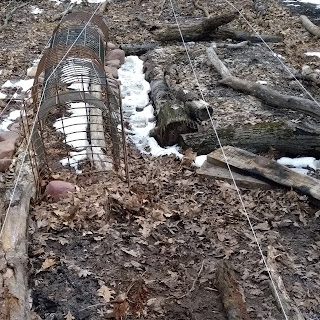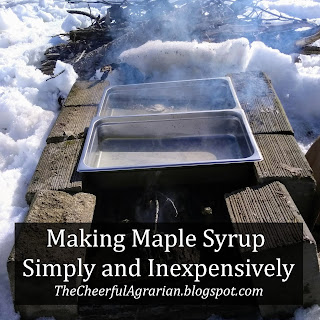If you go to
Leader Evaporator (one of the main maple syrup suppliers in the United States), you'd be tempted to feel like you need to be independently wealthy to afford to make your own syrup. The smallest evaporator they sell ("Ideal for the backyard sugar maker with just 15 to 50 taps") costs $1,370. For me, not being independently wealthy (unfortunately this blog hasn't brought me the fame and fortune certain articles on Pinterest would lead me to expect 😉) and with only a couple dozen maple trees big enough to tap on our property, there's no way a setup like that was going to be worth it for us.
Thankfully, I have friends and family who've made maple syrup on a small scale
(here's my sister-in-law, Mama Hen's, blog post about their first time making syrup), so I knew it was possible without breaking the bank. It still seemed a little overwhelming, though, which is why I went to Sam Thayer's class at Forager's Harvest
(you can see my post about that here). During his presentation, he showed us a super simple setup for trying out making syrup. The basic idea is to set up two lines of cement blocks, build a fire between them, and then support three
buffet service pans on the blocks. You fill the pans about one inch deep with sap and let them boil down, moving the more-finished sap into one pan, the fresh sap into the pan on the other end, and the half-done sap in the middle pan.
Since I already had some retaining wall blocks on the property (gotta love obtanium!), I didn't have to buy those, so my whole setup, including taps, bag holders, bags, and pans, cost me $150 (which I figured is about what three gallons of maple syrup would cost to buy locally). This method is a lot more time-intensive than using a professional quality evaporator would be, but as I said in a
previous post, it's time doing something I'd enjoy doing anyway. When it gets to the point that it's taking too much time, or taking time from other things I'd like to do, then I'll have to decide if I want to buy equipment to make the process more streamlined, or stop making syrup myself and go back to buying from my friends and family. But for now, just trying it out on a hobby level, this is a great way to do it.
So what are the bare minimum things you need to make maple syrup? Of course you'll need some kind of taps for your trees (
this is the kind I bought, although I'd prefer stainless steel if I could find them). You'll also need a drill bit of the same size as your taps (it's recommended to buy one especially for tapping, since you're making food (so you don't want to use a rusty old bit, used for who-knows-what, out of the bottom of your tool bag), and you want it as sharp as possible to minimize damage to your trees). I also like to sanitize my bit between trees, just to make sure I don't transfer diseases from tree to tree, so I dip the drill bit in a jar of rubbing alcohol after I finish drilling each tap hole.
You'll also need something to collect the dripping sap in. The cheapest I've found is to take an old (very clean) milk jug, vinegar bottle, or plastic coffee container, punch a hole in the side, and hang that from your tap. Or you can buy
metal hangers and blue plastic bags, which is pretty standard. Friends of ours use something similar to
this setup with a short length of PVC pipe, which cuts cost (the metal hangers cost about $4 a piece locally; the bags themselves only cost about 30 cents if you buy them in bulk). I bought 10 of the metal hangers and blue plastic bags to start; when I tapped additional trees I just used milk jugs. To be honest, I think I prefer the milk jugs because the sap inside stays cleaner - since they have a closed cap, they get far fewer bugs, twigs, and bits of tree bark in them. If I were starting over again, I would have saved the $40 on bag hangers and just used milk jugs to begin with.
Then you'll need something to gather the sap from your collection containers; I use a food safe 5 gallon bucket I've had for a while (I think it was originally for a bucket of pickles we had at church - I made sure the smell had dissipated before I used it for syrup!) I usually wait to boil until I have at least 5 gallons of sap; if I don't have enough, I'll store it in my spare refrigerator in ice cream buckets or gallon-sized glass jars. Since sap is basically sugar water, it goes bad very quickly (it can spoil in around a day at room temperature), so if you can't boil right away you'll need to refrigerate or freeze it. If you're working with small enough quantities, this can be workable, but obviously if you're getting more than 5 gallons a day storage can become a major issue, and you will need to cook your sap more often.
When you're ready to boil down the sap, you want to find a pot with as much surface area as possible, so it can boil off as quickly as possible.
These buffet pans work great, but
a large stock pot or
enameled canning kettle would work well, too (and be useful for other applications as well - although after being over the fire they do get pretty thoroughly blackened).
When you've boiled most of the water away, you can bring the remaining almost-syrup into the kitchen to be finished off in a regular soup kettle. Technically you could finish your syrup over the fire, but getting your syrup to the right final temperature can be tricky, and finishing in the kitchen gives you more control. I like to strain my syrup at this point; it's much easier to strain before it's in its final thick syrup state, and you will get ashes in your pans when you cook over an open fire. I strain my sap through a piece of cloth set into a
fine metal strainer (a
flour sack type towel would work fine - make sure you get it damp first or it may just hold the sap without letting it strain through - guess how I know this?😉) This works well enough for syrup you're going to consume yourself and you're not planning to sell.
When I first tried this method, I was worried that the syrup would end up tasting smoky from the long boil over the open fire. Much to my relief, my finished syrup tasted just like any other maple syrup I've ever bought. Definitely make sure you filter after you bring it into the house to get the ashes out, though.
You'll want to make sure you have an
accurate thermometer. For small home batches, you can test your syrup by bringing it up to 7.1 degrees higher than the boiling point of water (which can vary by elevation - around here that works out to 217.1 degrees Fahrenheit). At this point, it should sheet off of the back of a spoon, similar to when you test jelly.
And you're done! All that's left is bottling it up - I just use
quart size canning jars for ours, but you can use any container you like.
As you can see, if you're just starting out and only tapping a few trees, there's really not much you
have to buy - you can make do with many of the things you already have in your kitchen. There are definitely things that will make things go faster or more smoothly, but if you're just testing the water and this is something you're not sure you want to spend a lot of money on, there are definitely ways to do it inexpensively!
You can read more about my maple syrup adventures
here,
here, and
here.













